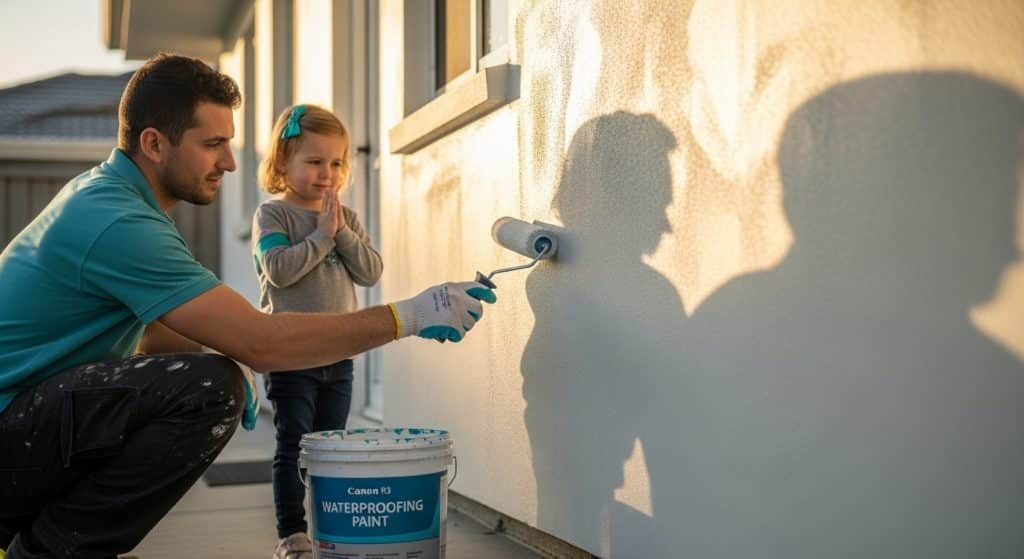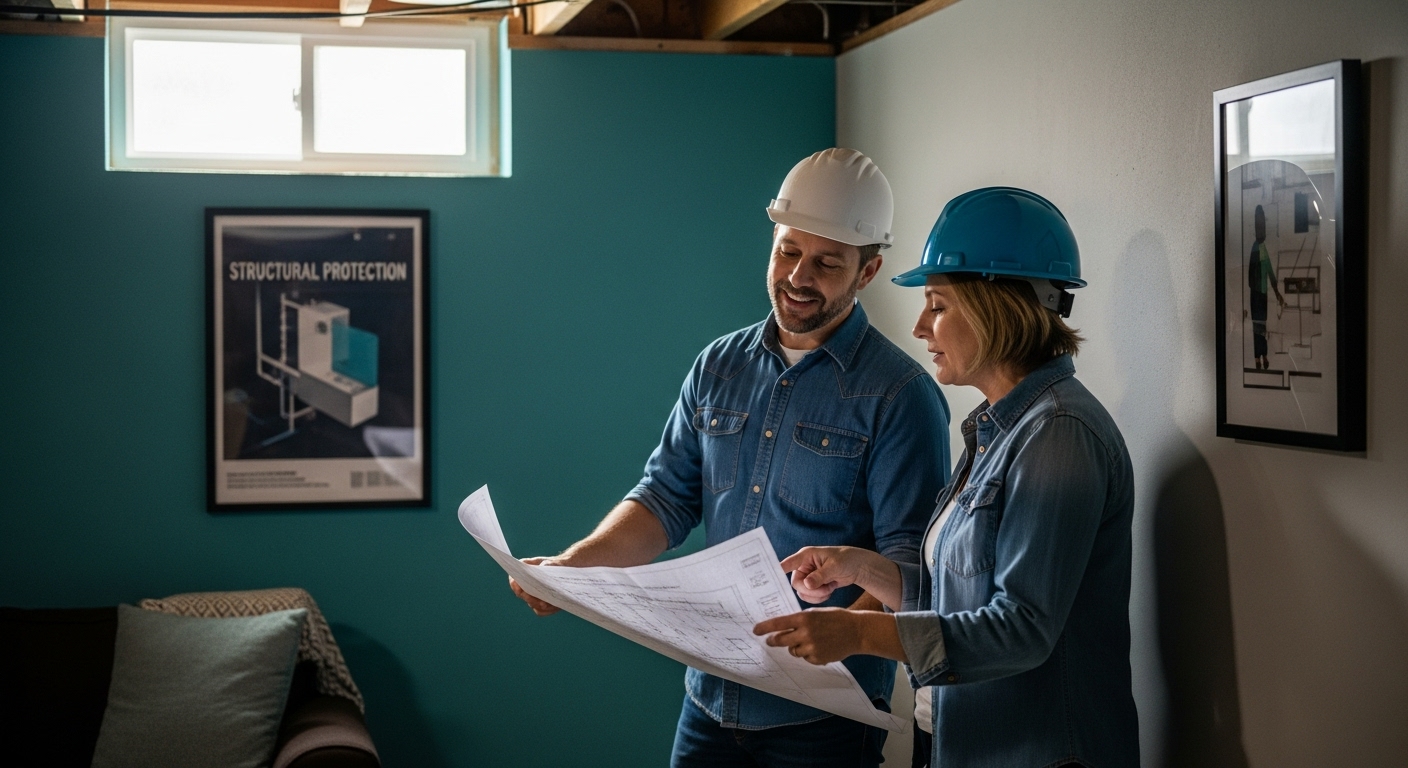Water damage is one of the biggest threats to any building, with repairs sometimes costing over 50 percent more when structures lack proper moisture protection. Most people think ordinary paint is enough to shield walls and foundations but that belief leaves properties vulnerable to relentless leaks and mould growth. The real defence against costly structural problems lies in a special kind of paint that does far more than simply add colour – it blocks water at the microscopic level and could save a fortune in the long run.
Table of Contents
- Defining Waterproofing Paint: A Simplified Explanation
- The Importance of Waterproofing Paint for Buildings
- How Waterproofing Paint Works: Key Concepts Explained
- Types of Waterproofing Paint and Their Applications
- Real-World Benefits of Using Waterproofing Paint
Quick Summary
| Takeaway | Explanation |
|---|---|
| Waterproofing paint creates a barrier against moisture. | This specialised paint prevents water from penetrating surfaces, protecting against damage. |
| It enhances structural durability and longevity. | Waterproofing paint preserves the integrity of buildings, preventing moisture-related deterioration that could lead to significant repairs. |
| Different types serve specific applications. | Acrylic, bituminous, cementitious, and polyurethane paints offer tailored solutions depending on the surface and environmental exposure. |
| Proactive application reduces long-term maintenance costs. | Investing in waterproofing paint minimises future repair expenses by protecting materials from moisture intrusion. |
| It mitigates health risks associated with dampness. | Effective waterproofing controls humidity levels, reducing the risk of mould and other moisture-related health issues. |
Defining Waterproofing Paint: A Simplified Explanation
Waterproofing paint represents a sophisticated protective solution designed to shield surfaces from moisture penetration. Unlike standard paint, this specialised coating offers comprehensive protection by creating an impermeable barrier that prevents water intrusion and potential structural damage.
The Fundamental Composition
At its core, waterproofing paint contains unique chemical formulations engineered to block water molecules. Research from material science experts reveals these paints incorporate advanced resins and polymeric additives that form a continuous, seamless film when applied to surfaces. The molecular structure of these specialised paints allows them to:
- Create a hydrophobic surface that repels water
- Seal microscopic cracks and surface imperfections
- Provide long lasting moisture resistance
How Waterproofing Paint Functions
The mechanism behind waterproofing paint is fundamentally different from conventional painting techniques. When applied, these specialised coatings penetrate surface pores and create a robust, elastic membrane that expands and contracts with temperature changes. This dynamic protective layer ensures comprehensive coverage against water infiltration.
Learn more about our comprehensive waterproofing solutions to understand how these innovative technologies can protect your property from potential water damage. Whether you are dealing with exterior walls, roofs, basements, or other vulnerable surfaces, waterproofing paint offers a strategic defence mechanism against moisture related deterioration.
The Importance of Waterproofing Paint for Buildings
Waterproofing paint serves as a critical protective strategy for buildings, offering far more than aesthetic enhancement. This specialised coating plays a vital role in preserving structural integrity and preventing costly long term damage caused by moisture infiltration.
Structural Protection and Longevity
Buildings constantly face environmental challenges that can compromise their durability. Structural engineering research indicates that water penetration represents one of the most significant threats to construction materials. Waterproofing paint provides a robust defence mechanism by:
- Preventing moisture related structural degradation
- Protecting building foundations from water damage
- Reducing potential for mould and mildew growth
- Extending the overall lifespan of building materials
Economic and Maintenance Benefits
The financial implications of implementing waterproofing paint extend well beyond initial application costs. Proactive waterproofing significantly reduces long term maintenance expenses by minimising potential structural repairs. Understand our comprehensive waterproofing approaches to comprehend how strategic protection can save substantial repair investments.
Professional assessments reveal that buildings without proper waterproofing can experience exponential degradation rates. Moisture intrusion leads to concrete erosion, steel reinforcement corrosion, and compromised structural stability. Waterproofing paint acts as a critical barrier, preventing these potentially catastrophic developments and maintaining the building’s structural soundness.
How Waterproofing Paint Works: Key Concepts Explained
Waterproofing paint operates through sophisticated chemical and physical mechanisms designed to create an impenetrable protective barrier against moisture. This specialised coating goes beyond traditional painting techniques by implementing advanced technological strategies to prevent water infiltration.
Molecular Barrier Formation
Research on waterproofing technologies demonstrates that waterproofing paint functions through intricate molecular interactions. When applied, these paints create a continuous, elastic membrane that transforms surface characteristics by:
- Blocking microscopic surface pores
- Generating a hydrophobic molecular structure
- Establishing chemical bonds with underlying surface materials
- Enabling dynamic expansion and contraction with temperature shifts
Protective Mechanism Dynamics
The paint’s protective mechanism relies on specialised polymeric compounds that penetrate surface irregularities.
These advanced formulations create a seamless, water resistant layer that adapts to structural movements and environmental changes. Learn about our advanced waterproofing techniques to understand the comprehensive science behind moisture protection.
Unlike standard paint, waterproofing solutions actively resist water molecule penetration through their unique chemical composition.
The following table presents the main mechanisms by which waterproofing paint provides effective protection, helping readers to understand how each feature functions at a technical level.
| Protective Mechanism | Description |
|---|---|
| Hydrophobic Surface Formation | Creates a water repellent layer that prevents water absorption |
| Pore Sealing | Penetrates and blocks microscopic cracks and voids |
| Elastic Membrane | Forms a flexible film that adapts to structural movement and temperature |
| Chemical Bonding | Bonds with the surface material to enhance durability and protection |
| Thermal Insulation | Contributes to improved surface insulation and energy efficiency |
Types of Waterproofing Paint and Their Applications
Waterproofing paints represent a diverse range of protective solutions, each engineered to address specific environmental challenges and surface requirements. Understanding these variations helps property owners select the most appropriate protective coating for their unique needs.
Classification by Chemical Composition
Specialist material research identifies several primary categories of waterproofing paint, each with distinctive characteristics and performance attributes:
- Acrylic Based Paints: Versatile coatings ideal for exterior surfaces
- Bituminous Paints: Excellent for underground and foundation protection
- Cementitious Paints: Perfect for concrete and masonry structures
- Polyurethane Paints: Superior flexibility for surfaces experiencing significant movement
Targeted Application Strategies
Each waterproofing paint type serves specific architectural and environmental contexts.
Selecting the correct paint depends on multiple factors including surface material, moisture exposure, and structural dynamics. Learn about our comprehensive waterproofing approaches to understand how professional assessment determines the most effective solution.
For instance, basement walls require different waterproofing strategies compared to roof surfaces.
To clarify the differences between the main types of waterproofing paint discussed, the following table compares their composition, ideal application areas, and typical protective features.
| Type of Waterproofing Paint | Main Composition | Ideal Application | Key Protective Features |
|---|---|---|---|
| Acrylic Based | Acrylic resins | Exterior walls, general surfaces | Versatile, weather resistant, quick drying |
| Bituminous | Bitumen compounds | Foundations, underground structures | Excellent moisture and chemical resistance |
| Cementitious | Cement based | Concrete, masonry, water tanks | Strong adhesion, suitable for porous areas |
| Polyurethane | Polyurethane resins | Roofs, terraces, surfaces with structural movement | High elasticity, UV and weather resistance |
Real-World Benefits of Using Waterproofing Paint
Waterproofing paint transcends simple surface protection, offering comprehensive advantages that safeguard property investments and enhance structural resilience. These specialised coatings deliver multifaceted benefits that address both immediate and long term building maintenance challenges.
Structural Preservation and Health Protection
Scientific research demonstrates that effective waterproofing significantly reduces moisture related health risks and structural deterioration. The protective layer provides critical advantages by:
- Preventing rapid structural material degradation
- Mitigating potential mould and bacterial growth
- Reducing indoor humidity and associated respiratory risks
- Maintaining building aesthetic and functional integrity
Economic and Maintenance Advantages
Waterproofing paint represents a strategic long term investment in property maintenance. By creating an impenetrable barrier against moisture intrusion, these specialised coatings minimise expensive repair requirements and potential structural compromise. Explore our comprehensive waterproofing solutions to understand how professional application can transform your property protection strategy.
Beyond immediate water resistance, these advanced coatings contribute to improved thermal insulation, enhanced surface durability, and reduced maintenance cycles. Property owners can expect significant cost savings through proactive application, with waterproofing paint acting as a critical defence mechanism against environmental degradation.
Protect Your Property from Hidden Water Damage
Struggling with persistent damp, peeling paint, or cracked walls? As highlighted in our article, understanding how waterproofing paint acts as a true moisture barrier is essential for any property owner. Left untreated, water infiltration can silently erode structural integrity and lead to escalating repair costs. Your property deserves proactive defence using specialised coatings that work at a molecular level to block every drop where it matters most. For guidance directly addressing these concerns, browse our Uncategorized insights for focused advice.
Do not wait for water damage to become a crisis. Take charge by partnering with the professionals trusted throughout South Africa. Visit Pro Waterproofing to request your tailored assessment today. Feel confident about your next steps with our expert support and discover solutions proven to extend your building’s lifespan. Now is the moment to invest in true peace of mind.
Frequently Asked Questions
What is waterproofing paint?
Waterproofing paint is a specialised coating designed to create an impermeable barrier, protecting surfaces from moisture penetration and potential structural damage.
How does waterproofing paint work?
Waterproofing paint works by penetrating surface pores and forming a robust, elastic membrane that repels water and expands or contracts with temperature changes, ensuring comprehensive protection against water infiltration.
What are the different types of waterproofing paint?
The primary types of waterproofing paint include acrylic-based, bituminous, cementitious, and polyurethane paints, each suitable for specific surfaces and environmental conditions.
What are the benefits of using waterproofing paint for buildings?
Using waterproofing paint helps preserve structural integrity by preventing moisture-related damage, reducing maintenance costs, and mitigating potential health risks from mould and mildew growth.



